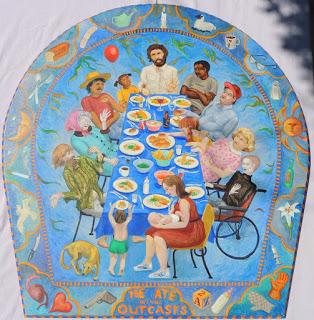
Because of the very powerful slaveholder religion (and here) crafted by Southern Christian apologists for slavery, which pretends that salvation and Jesus are all about the "spiritual" realm and not this world and the muddy, sordid political realities that shape this world, many American Christians find it distasteful to talk about Jesus, or Easter, and the political at the same time.
"Jesus is above politics," those Christians, echoing slaveholder Christianity, want to say. "Give the politics a break on Easter day!"
What this slaveholder Christianity that spiritualizes Jesus, his cross and resurrection, removing them from the real world in which we live out our salvation, does to Jesus' crucifixion and resurrection is this: it depoliticizes these events — as if Jesus were executed by the Romans via a sentence of capital punishment for no reason at all. When it's clear from the testimony of the Christian gospels that he was executed by the Roman empire because his life and his teachings were seen as posing a serious political threat to the empire — even if the gist of his message and his lived testimony were not explicitly political . . . .
Scripture scholars point out that one of the most radically threatening practices of Jesus, one that brought him to the attention of the imperial authorities and resulted in his execution, was his practice of open commensality — his practice of an open table. To which he invited outcasts, people considered nobodies in his society, people considered dirty, sinful, beyond the pale . . . .
People with whom "good" and "religious" folks did not sit down at table, since it was thought that, in eating with a dirty, sinful person, one made oneself dirty and sinful, too . . . . Here is some good commentary on these themes by two good scripture scholars, Marcus Borg and John Dominic Crossan, with Adam Gopnik, a food historian and culture critic, echoing this biblical scholarship:
The meals of Jesus embodied his alternative vision of an inclusive community. . . . Ultimately, the meals of Jesus are the ancestor of the Christian eucharist.
~ Marcus Borg, Meeting Jesus Again for the First Time (NY: Harper, 1994), p. 56.
Most of Jesus' first followers would have known about but seldom experienced being served at table by slaves. The male followers would think more experientially of females as preparers and servers of the family food. Jesus took on himself the role not only of servant but of female. Not only servile but female hosting is symbolized by the juxtaposition of those four verbs. Far from realizing and being served, Jesus himself serves, like any housewife, the same meal to all, including himself.
~ John Dominic Crossan, Jesus: A Revolutionary Biography (NY: HarperCollins, 1994), p. 181.
The deliberate conjunction of magic and meal, miracle and table, free compassion and open commensality, was a challenge launched not just on the level of Judaism's strictest purity regulations, or even on that of the Mediterranean’s patriarchal combination of honor and shame, patronage and clientage, but at the most basic level of civilization's eternal inclination to draw lines, invoke boundaries, establish hierarchies, and maintain discriminations. It did not invite a political revolution but envisaged a social one at the imagination’s most dangerous depths. No importance was given to distinctions of Gentile and Jew, female and male, slave and free, poor and rich. Those distinctions were hardly even attacked in theory; they were simply ignored.
~ Ibid., p. 196.
It isn't an accident that Jesus's most original act was at a table, too, which seemed so shocking to a peasant honor society, where values depended on clean and unclean. Jesus would eat with anybody, whores and tax collectors, Gentiles and tribesmen. What did he eat? We can't be sure, but we know he liked wine enough to make a lot. He ate what he liked where he liked with whom he liked, at a table open to all.
~ Adam Gopnik, The Table Comes First: Family, France, and the Meaning of Food (NY: Vintage, 2012), p. 309.
The photo at the head of the posting is of a painting by artist Margaret Puckette that I commissioned and own. It hangs in our dining room

